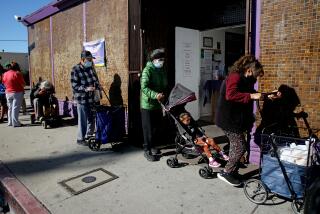What can Houston teach Los Angeles about solving homelessness?

- Share via
The struggle to solve homelessness is getting harder nearly everywhere. Yet recent years have still seen many more victories than defeats. And the biggest victory is in greater Houston, which over the last decade has cut homelessness by more than half.
Houston’s story holds lessons for Los Angeles. The chief one is that solving homelessness is less about economics than about strategic clarity and execution.
Evidence that homelessness is not an inescapable fact of modern post-industrial life is not hard to find. From the time systematic counting began in 2007 to the last official count in 2020, the homeless population fell nationwide by 10.3%.
The decline has been especially significant among homeless families with children, which is particularly good news.
If that good news seems too removed from the particular woes of West Coast mega-cities, note that while homelessness in Los Angeles County was doubling over the last decade, it was significantly dropping in Long Beach — in the same crazed Southern California housing market and same unequal local economy. It’s also fallen in Pasadena and Glendale, the two other cities that handle homelessness separately from the rest of the county.
L.A. and Houston are the second- and fourth-largest cities in the country, two vast, highly diverse Sun Belt sprawls. Houston has slightly higher poverty levels, while L.A.’s unemployment rate fell close to Houston’s leading into the pandemic.
One significant difference: Rents in Los Angeles are much higher than in Houston. This gave L.A. a much bigger homelessness problem even when it was half its current scale.
In many ways, Houston has the harder battle.
Among 15 metropolitan areas tracked by the U.S. Bureau of Labor Statistics, Greater Los Angeles had the highest wage growth in the nation in the 12 months that ended in September. Houston ranked near the bottom.
Houston has fewer affordable housing units per extremely low-income families than any U.S. city but Las Vegas. Los Angeles is only slightly better.
Over much of the past decade, Houston’s Harris County had the highest eviction rate in the nation after New York City.
Yet Houston continues to hold its ground against homelessness. Here’s how the city has done it:
Scale of effort. Houston provides many times more affordable permanent housing units — much of it including supportive health and social services — than its headcount of the homeless population on any given night, according to Houston’s Coalition for the Homeless. Permanent housing has been its whole focus. Temporary shelter is left entirely to churches and other nonprofits.
To approach Houston’s effort — and offer enough permanent housing to cut its nightly homeless population by half — L.A. would have to multiply its efforts by more than fivefold to provide at least 150,000 total units, according to my analysis of recent housing data.
Excellent organization. Greater Houston’s single lead homeless agency orchestrates its services supremely well. Its efforts include integrating front-line health and housing services workers, training them to understand each other’s jargon and pioneering a shared database for tracking all official interactions with people experiencing homelessness, their needs and their use of services.
Pragmatism. Houston appears not to have let compassion for the homeless warp into a respect for homelessness itself. The focus has been on making homelessness “rare, brief and nonrecurring,” and not necessarily a more comfortable option. Houston has decommissioned eight homeless encampments in the last year, offering residents a path into permanent housing. Between 85% and 90% of homeless people take up that offer. Those who don’t still have to move on from the encampments.
Houston’s approach can be summed up as strategic clarity.
Those who work on solving homelessness in Los Angeles understand this. The architect of the Houston system was even brought in to consult on organizing the L.A. system.
But what makes this so hard for Los Angeles?
Strangely, it’s not the cost of real estate that gets in the way of building more housing. Studies put land costs at only about one-eighth of the total cost of building supportive, affordable housing in L.A.
It’s not the mashup of jurisdictions involved. Houston’s homelessness agency straddles three counties and many municipalities — not to mention the tensions of operating a city that leans politically blue in a ragingly red state. Los Angeles looks almost seamless by comparison.
It’s not race that differentiates. Black people are highly overrepresented among the homeless everywhere. Houston has a much higher Black population than Los Angeles but much lower homelessness.
Here’s what makes progress hard in Los Angeles:
No one’s in charge. Individual leaders buzz with impatience for action; saintlike individuals produce quiet acts of compassionate heroism — but the systems exude a muddy lack of urgency. No government or agency has the authority or mandate to assert leadership, set priorities and take decisive action in dealing with homelessness. Unlike Houston, Los Angeles has a weak-mayor system, no top-elected official in the county and no executive position with a comparable agenda-setting power. The many local bureaucracies involved are a confused tangle of mismatched authorities, responsibilities and resources.
Los Angeles doesn’t know what it wants. Housing growth has been deliberately slowed by 40 years of zoning restrictions, says Jason Ward, an economist at the Rand Corp. That can make sense in a place that ships its water in from a different climate zone, is strangled with traffic, surrounded by wildfire risk and sits astride a major earthquake fault. It also serves voters who want to protect their own property values. All these legitimate concerns — regulated with maddening inefficiency — serve as a roadblock to affordable housing. Even the labor protections baked into Proposition HHH’s $1.2 billion to fund homeless housing, according to a recent Rand study, may ultimately cost Los Angeles 800 additional housing units.
L.A.’s compassion is conflicted. It vacillates between wanting to end homelessness and making homelessness more comfortable. In reviewing the academic literature on the economics of homelessness, Columbia University professor Brendan O’Flaherty concluded that many of the measures projected for Los Angeles under Proposition HHH “are designed not to reduce street homelessness, but to create a large but well-groomed and well-mannered street population: dedicated parking lots, storage facilities for possessions, portable toilets, and drop-in and hygiene centers.”
Every step that makes street homelessness a little less uncomfortable has the unintended consequence of drawing more people into the streets. The clearest evidence of this was the aftermath of a 2012 court ruling that forbade the city of Los Angeles from seizing property on skid row without a specific legal reason. Because the ruling applied only to the city, in the two years straddling the ruling unsheltered homelessness rose within city limits at 10 times the rate of the rest of L.A. County.
While the court ruling showed a reasonable respect for people with very little stuff and nowhere to put it, it also showed the huge elasticity of street homelessness.
Those trying to solve homelessness in Los Angeles are seen as capable and committed. Likewise, surveys show Angelenos are concerned about the impact of homelessness on neighborhood quality of life as well as the hardships homeless people endure. Holding those two legitimate concerns simultaneously is strikingly mature and healthy.
But strategic clarity and crisp execution have been painfully slow in coming. About a thousand of the 10,000 affordable units promised by Proposition HHH, passed in 2016, have been opened — at astronomical costs.
The takeaway from Houston is that L.A.’s problem is, at its root, an organizational problem, and there’s opportunity in that. If Los Angeles could to a significant degree achieve clarity of purpose around homelessness, fully empower an agency to own it — and align the rest of the bureaucracies to work together — that approach could serve as a template for how L.A. can organize itself more effectively and inclusively as a high-functioning community.
Meanwhile, real progress in affordable housing will probably take place in tens of thousands of backyards and former garages as restrictions fall away for accessory dwelling units and single-family zoning ends.
Many people now living on the streets still won’t fit in that world. To house them, and to reclaim the public spaces they inhabit, Los Angeles will need to decide what it really wants for these struggling people, then organize itself to achieve it on a much greater scale.
Marshall Ingwerson is a journalist and former editor in chief of the Christian Science Monitor. He is developing a project to spread public awareness of data-based successes on issues of public concern, The What Works Initiative.
More to Read
A cure for the common opinion
Get thought-provoking perspectives with our weekly newsletter.
You may occasionally receive promotional content from the Los Angeles Times.










